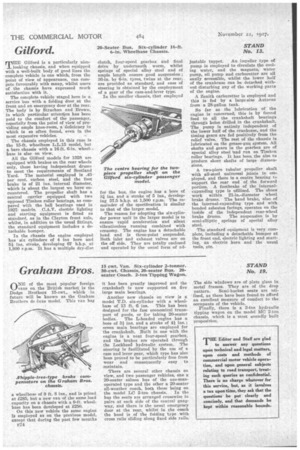Gifford.
Page 148

If you've noticed an error in this article please click here to report it so we can fix it.
THE Gilford is a particularly nicelooking chassis, and when equipped with a well-built body of good lines the complete vehicle is one which, from the point of view of appearance, can compete favourably with many, whilst users of the chassis have expressed much satisfaction with it.
The complete vehicle staged here is a service bus with a folding door at the front and an emergency door at the rear. The body is by &radian and Brown, in which particular attention has been paid to the comfort of the passenger, espeCially from the point of view of providing ample knee-room, a deficiency in which is so often found, even in the most expensive vehicles.
The chassis employed in this case is the 15-ft. wheelbase L.L.15 model, but a bare chassis with a 16-ft. 6-in, wheelbase is also on view.
All the Gilford models for 1l!28 are equipped with brakes on the rear wheels only, these having independent drums to meet the requirements of Scotland Yard. The material employed is .45 per cent, carbon steel, and the foot brake is of 21 ins, internal diameter, which is about the largest we have encountered. The propeller shaft has a central carrier equipped with two opposed Timken roller bearings, as compared with the ball bearings used in 1927 models. C.A.V. electric lighting and starting equipment is fitted as standard, as in the Clayton front axle, whilst, in addition to the usual fittings, the standard equipment includes a detachable bumper.
In the chassis the engine employed has six cylinders of 4 ins bore and 51 ins. stroke, developing 67 b.h.p. at 1,800 r.p.m. It has a multiple dry-disc clutch, four-speed gearbox and final drive by underneath worm, whilst springs of special alloy steel and of ample length ensure good suspension ; 36-in. by 6-in. tyres, twins at the rear, are provided as standard, and ease of steering is obtained by the employment of a gear of the cam-and-lever type.
In the smaller chassis, that employed
for the bus, the engine •has a bore of 34 ins, and a stroke of 5 ins., developing 57.5 b.h.p. at 1,500 r.p.m. The remainder of the specification is similar to that of the larger model.
The reason for adopting the six-cylinder power unit in the larger model is to ensure rapid acceleration and silent vibrationless running combined with economy. The engine has a detachable head and is three-point suspended. Both inlet and exhaust valves are on the off side. They are totally enclosed and operated by the usual form of ad
justabIe tappet. An impeller type of pump is employed to circulate the cooling water, and the magneto, water pump, oil pump and carburetter are all easily accessible, whilst the lower half of the crankcase can be detached without disturbing any of the working parts of the engine.
A Zenith carburetter is employed and this is fed by a large-size Autovac from a 28-gallon tank.
So far as the lubrication of the engine is concerned, this is by forced feed to all the crankshaft bearings througa holes drilled in the crankshaft. The pump is entirely independent of the lower half of the crankcase, and the timing gears are fed positively from the relief valve. The rest of the chassis is lubricated on the grease-gun system. All shafts and gears in the gearbox are of special alloy steel land run on Timken roller bearings. It has been the aim to produce short shafts of large diamensions.
A. two-piece tubular propeller shaft with all-steel universal joints is employed, and there is a centre bearing to support the rear end of the forward portion. A footbrake of the internalexpanding type is utilized. The shoes work within 21-in.-diameter wheel brake drums. The hand brake, also of the internal-expanding type and with bonded asbestos facings, operates on the inside of the independent rear-wheel brake drums. The suspension is by semi-elliptic springs of special alloy steel.
The standard equipment is very complete, including a detachable bumper at the front end, electric lighting and starting, an electric horn and the usual tools, etc. '


















































































































































































































































































































